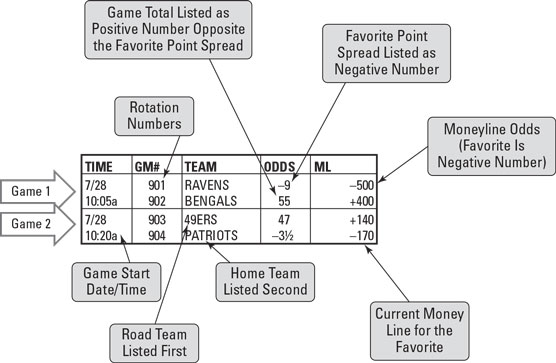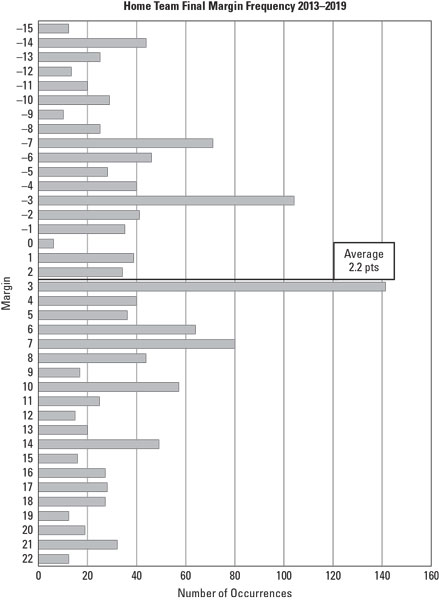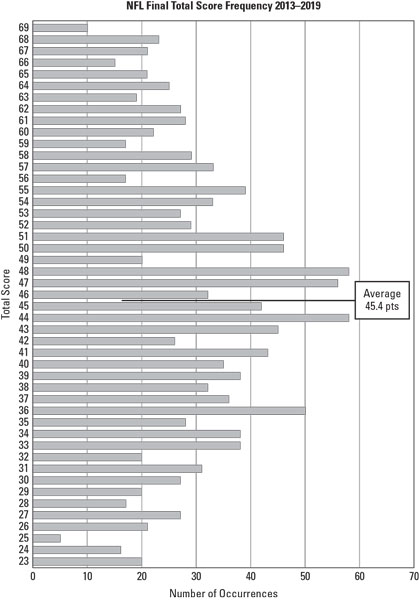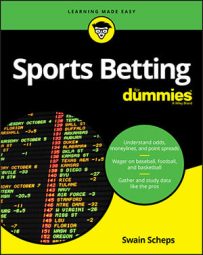Odds notation
Nothing should surprise you about the basic odds listing of an NFL game. The following figure gives you a summary. How odds for NFL games are displayed.
How odds for NFL games are displayed.In compact settings, bookmakers don’t bother telling you that the favorite’s point spread is –4 and the underdog’s point spread is +4. They assume you know that’s the way point spreads work, so they use the space to list the favorite spread and the total.
Derivative betting and props
NFL football has a full slate of derivative bets on each of the big three (moneyline, point spread, and total), where bettors can bet 1st quarter and 1st half pregame nearly everywhere, and preemptive bets on all quarters and the 2nd half at some of the larger books. Other popular derivative bets include team total points for the full game, halves, and quarters.NFL prop bets are some of the most extensive on offer due to the stat-heavy nature of the game now. Plus, it helps that there’s no squeamishness with betting on individual athletes on performance stats like yardage totals, total carries, total catches, scoring, and more.
Depending on the betting venue, NFL games are set up perfectly for in-game betting on propositions like whether the next drive will end in a touchdown, field goal, punt, or turnover. Some bookmakers even offer app-based betting on whether an upcoming play will be a run or a pass.
Futures betting for the NFL
NFL bettors have a full menu of off-season betting options, the most common futures being the following:- Team regular season win total (over/under)
- Team to make the playoffs (yes/no)
- Division championship (multiway moneyline bet)
- Conference championship (multiway moneyline bet)
- Super Bowl champion (multiway moneyline bet)
- Individual player season stat totals (over/under)
Betting sides for the NFL
The public loves betting the favorites in NFL football. You need to aware of some key numbers.I use the term key number to define a score or margin that is relatively more likely to appear. Because football is most often scored in 7s and 3s, games tend to end at a final margin derived from them. That’s why 10-point wins or 13-point wins are more likely than a 12-point wins.
Bookmakers take this into account in football point spreads and totals, not just when they set odds, but when they move odds. You’ve learned in earlier chapters that if the action is too lopsided on one side of the betting, the oddsmaker responds by altering the odds to make the “overbet” side more expensive, thus making the other side of the bet cheaper.
In a game where all outcomes are equally likely, the bookmaker would have a set level of betting imbalance that would trigger a point spread change. But the wide variation in the likelihood of football outcomes means oddsmakers have corresponding variance in the amount of over-betting they have to see before they’ll move the odds in a football game.
Look at the following figure and you’ll see the frequency of NFL final margins. For example, because a football game margin of 12 points is just as likely as 13 points, oddsmakers (and sharp bettors) don’t see much difference between those two spreads. But 14 is a key number, so bookmakers require a much bigger market signal before they’ll move a point spread from 13-1/2 to 14.
 NFL key numbers for point spread betting.
NFL key numbers for point spread betting.Key spread numbers
The lumpy nature of the NFL’s margins leads to certain point spreads being stickier than others. Fully 40 percent of NFL games end with a margin of exactly 3, 6, 7, 10, or 14. A bookmaker who opens a team at –7 will require significantly more action to move the spread to –7-1/2 because it’s such a major stopping point for game margins.And 3 points is another key number. Fully 8 percent of NFL home teams win by exactly 3 points, which means there’s a huge difference in betting on a home favorite at –2-1/2 versus –3-1/2, even though they’re only an extra point apart. If this were a game scored one point at a time (like volleyball perhaps), the oddsmaker would be indifferent about moving the point spread smoothly up or down as action becomes unbalanced. Not so with football.
The lesson: Shop around. When you’re thinking of betting a side that’s lined in the neighborhood of +3 points, shop around and see if you can find +3-1/2. And by the same token, as an underdog bettor, you can’t consider +2-1/2 and +3 to be in the same probability neighborhood as you might think of +4-1/2 and +5.
Betting at +5 rather than +4-1/2 will almost never matter. Five is an incredibly rare game margin. In the last 20 years, there have been 77 games lined at +4-1/2, and in only one case (1.2 percent) did a team getting 4-1/2 points lose the game by exactly 5 points. That means the difference between those two-point spreads is almost nothing. In fact, if you were betting on a team at +5 and you had a chance to sell a half point, it just might be worth it.Selling points
Selling points is an action you can take with some bookmakers when you’re finalizing a point spread bet. By giving back a half point on your point spread (for example, from +5 to +4-1/2), the bookmaker gives you a more advantageous payout schedule. (For example, instead of a –110 bet, or risking $110 to win $100, the bookmaker will ask you to risk $102 to win $100 as compensation for your half point.)Let’s look at the same half-point difference between +2-1/2 and +3. There have been 152 games in the last 20 years where the home team was a +2.5 underdog. In 13 (7.5 percent) of those games, the home team lost by exactly 3 points. So, you might say for underdog bettors, the half-point that moves you to 3 is worth 7 times as much as the half point that moves you to 5.
Is it worth it? Let me work it.
If you treat NFL margins and total score patterns as actual probabilities for the future, they become good-use cases for putting our knowledge of break-even winning percentage to work for us to compare two bets.In this case, we’re contemplating selling a half point back to the bookmaker in exchange for a more advantageous set of payout odds. Again, the bookmaker has offered to mover our odds from –110 to –102 if we’d be willing to move from +5 down to +4-1/2. Should we do it?
At –110, the break-even winning percentage is 52.38 percent. At –102 the break-even winning percentage becomes 50.2 percent. It might seem like small potatoes, but professionals are constantly on the lookout for advantages like this, as they would welcome a 2.18-percent edge because they know — like casinos — that tiny edges make a big difference in the long run. So now we look at what we lose when we give away that half point. As I discussed above, a 5-point margin is extremely rare. It only impacted 1 out of 77 games lined at +4-1/2, and a home team losing by 5 points at any spread has only happened about 1.5 percent of the time. But since the 2.18-percent advantage gained is more than the 1.5-percent advantage lost, you should make that bet. It’s a positive EV play, so sell that half point!
What about moving from +3 –110 down to +2-1/2 at –102 odds? We already know that at –110 we need to win 52.4 percent of the time to break even, and –102 gets us to 50.2 percent. But that 2.18-percent advantage we gain is outweighed by the fact that at +2-1/2, we know that 7.5 percent of the time, a bet that would have previously won for us will now only push. Stick to the three points unless the bookmaker can give you a better price for moving from +3 to +2-1/2.
There is a generic rule of thumb that the correct price for moving off of a key number in the NFL is 25 odds points, or in our case, moving from –110 to +115. In other words, if a bookmaker isn’t willing to up your moneyline by at least 25 odds points (and most won’t), don’t sell that 1/2 point. There are some excellent free calculators online that can help you work through the math on buying and selling half points on NFL bets.
Moneyline betting
Oddsmakers offer the usual handicap-free moneyline bets to bettors who aren’t interested in the point spread. The only thing you need to know about NFL moneylines is that they are tied into to the key numbers I talked about in the previous section.The table shows that a rough equivalent between an NFL moneyline and point spread (assuming –110 odds) on some key numbers.
| Favorite Point Spread | Moneyline | Historical Straight Up Win% | Underdog Point Spread | Moneyline | Historical Straight Up Win% |
| –2 | –130 | 59% | +2 | +110 | 41% |
| –2-1/2 | –140 | 58% | +2-1/2 | +125 | 42% |
| –3 | –155 | 58% | +3 | +140 | 42% |
| –3-1/2 | –175 | 63% | +3-1/2 | +155 | 37% |
| –4 | –200 | 66% | +4 | +170 | 34% |
| –6 | –270 | 72% | +6 | +210 | 28% |
| –6-1/2 | –300 | 84% | +6-1/2 | +220 | 16% |
| –7 | –330 | 75% | +7 | +250 | 25% |
| –7-1/2 | –360 | 82% | +7-1/2 | +280 | 18% |
| –9-1/2 | –400 | 76% | +9-1/2 | +300 | 24% |
| –10 | –450 | 75% | +10 | +325 | 25% |
These are rough equivalents. While point spreads can make the odds look placid and calm on the surface, moneylines are more prone to churn beneath the waves. Moneylines don’t automatically move in perfect sync with spread moves, and it’s not uncommon for bookmakers to use the moneyline as a way to fine-tune action on either side of a game. A typical NFL Sunday might have two games where the favorites are both listed at –3 +100, but one moneyline is set at –155 and the other is set at –145. The lesson? If you’re a moneyline bettor, shop around.
Total bets
Where other sports have smoother distributions of total scores, football does not, with its 6-point touchdowns and 3-point field goals. Bettors should treat totals like they do point spreads: warily. Some point totals are much more common than others, as you can see. NFL total scores average around 45.4 points.
NFL total scores average around 45.4 points. The frequency of total game scores.
The frequency of total game scores.NFL parlays
NFL moneylines, totals, and point spreads are available for betting in multi-way bets called parlays. A parlay is the equivalent of betting on one game and then automatically putting the winnings toward a second bet. The bookmaker kindly does this for you automatically. Best of all for NFL bettors, you don’t have to worry about the timing of the games; you can parlay games that start at exactly the same time, and they’re treated as if they get bet in sequence.Standard parlay payouts are as follows:
| 2 bets | 2.6 to 1 |
| 3 bets | 6 to 1 |
| 4 bets | 12 to 1 |
Parlay bets come with restrictions. Most bookmakers forbid you from parlaying an NFL spread and total on the same game.
For a parlay bet to win, every leg must win. Should one of the legs push, the parlay bet reverts to the odds of a parlay with one bet fewer. For example, if you were to bet a three-way parlay, three wins pays 6-to-1. If one of the best were to push, your parlay would be treated as a 2.6-to-1 two-way parlay.NFL teasers
NFL teasers are a popular multi-way play. Bettors get the benefit of a set number of points for as many different point spreads or totals as they choose.- For a 6-point teaser to break even, bettors must win each single leg 72.3 percent of the time.
- For a 6-1/2-point teaser to break even, bettors must win each single leg 73.8 percent of the time.
- For a 7-point teaser to break even, bettors must win each single leg 75.1 percent of the time.

